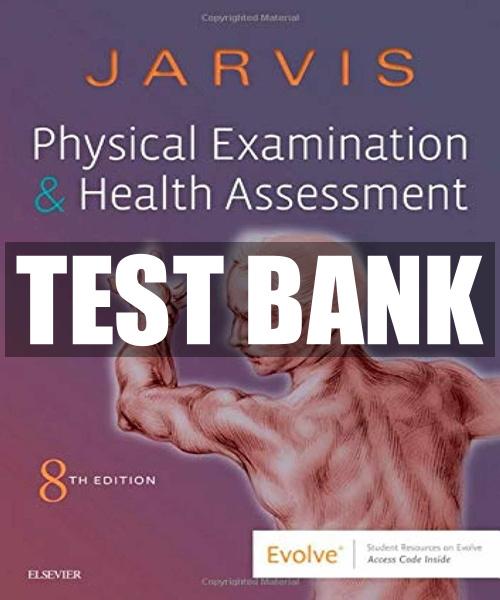Test Bank For Physical Examination and Health Assessment 8th Edition
Digital item No Waiting Time Instant DownloadISBN-13: 978-0323510806 ISBN-10: 0323510809
In Stock
Original price was: $55.00.$14.00Current price is: $14.00.
Test Bank For Physical Examination and Health Assessment 8th Edition
The “Test Bank for Physical Examination and Health Assessment, 8th Edition” by Carolyn Jarvis is a comprehensive educational resource designed to support nursing students and instructors in mastering the skills and knowledge required for effective physical examination and health assessment. This test bank is an essential complement to the 8th edition of the textbook, which is widely used in nursing and health sciences programs.
Key Features and Content of the Test Bank:
- Extensive Question Bank:
- The test bank includes a wide range of questions that correspond to the chapters of the textbook. These questions are crafted to evaluate students’ understanding of the material, including both the theoretical and practical aspects of physical examination and health assessment.
- Variety of Question Formats:
- The test bank offers various question formats, such as:
- Multiple-Choice Questions: Assessing students’ recall, understanding, and application of key concepts.
- True/False Questions: Testing students’ ability to distinguish between correct and incorrect statements related to physical examination techniques and findings.
- Short Answer Questions: Encouraging students to express their understanding and reasoning in a concise manner.
- Essay Questions: Providing an opportunity for students to explore topics in-depth and demonstrate critical thinking and comprehensive knowledge.
- The test bank offers various question formats, such as:
- Alignment with Textbook Content:
- The questions are closely aligned with the content of the 8th edition textbook, ensuring that they reflect the material covered in each chapter. This alignment helps students reinforce what they have learned in their readings and lectures.
- Coverage of Core Topics:
- The test bank covers a broad range of topics essential to physical examination and health assessment, including:
- Introduction to Health Assessment: Questions on the fundamental principles of health assessment, including patient history taking, interviewing techniques, and the health assessment process.
- Techniques of Physical Examination: Assessment of students’ knowledge of the various techniques used in physical examination, such as inspection, palpation, percussion, and auscultation.
- Assessment of Body Systems: Detailed questions on the assessment of different body systems, including:
- Cardiovascular System: Evaluation of heart sounds, pulses, and vascular assessment.
- Respiratory System: Techniques for assessing lung sounds, respiratory rate, and overall respiratory function.
- Neurological System: Questions on neurological assessment, including reflexes, sensory and motor function, and cranial nerve evaluation.
- Gastrointestinal System: Assessment of abdominal structures, bowel sounds, and related health concerns.
- Musculoskeletal System: Evaluation of joint function, muscle strength, and skeletal integrity.
- Integumentary System: Skin, hair, and nail assessment techniques and related health issues.
- Age-Specific Assessments: Questions covering health assessment across the lifespan, including pediatrics, adults, and the elderly.
- Cultural and Ethical Considerations: Questions on the importance of cultural competence and ethical considerations in health assessment.
- The test bank covers a broad range of topics essential to physical examination and health assessment, including:
- Realistic Case Scenarios:
- Many questions are based on realistic case scenarios, helping students apply their knowledge in practical situations. These scenarios are designed to simulate real-world clinical situations that students may encounter in their practice.
- Critical Thinking and Clinical Judgment:
- The test bank includes questions that require students to use critical thinking and clinical judgment. These questions challenge students to analyze data, make decisions, and prioritize care based on their assessments.
- Instructor Flexibility:
- Instructors can select and customize questions to create assessments that align with their course objectives and the specific needs of their students. The variety of question types allows for flexible test design, whether for formative quizzes, midterms, or final exams.
- Detailed Explanations:
- Many questions come with detailed explanations or rationales, particularly for complex scenarios or problem-solving questions. These explanations help students understand why certain answers are correct and reinforce learning.
Benefits of Using the Test Bank:
- Efficient Assessment Preparation: Instructors can efficiently prepare exams and quizzes with a variety of questions that thoroughly cover the textbook content.
- Enhanced Learning: Students can use the test bank questions to practice and reinforce their knowledge, improving their readiness for clinical practice.
- Comprehensive Coverage: Ensures that all critical aspects of physical examination and health assessment are assessed.
Conclusion:
The “Test Bank for Physical Examination and Health Assessment, 8th Edition” by Carolyn Jarvis is an invaluable resource for nursing educators and students. It offers a wide range of questions that thoroughly cover the essential skills and knowledge needed for effective health assessment. By using this test bank, students can gain confidence in their abilities to perform physical examinations and make informed clinical judgments, while instructors can create assessments that are both challenging and reflective of real-world clinical practice.


Reviews
There are no reviews yet.